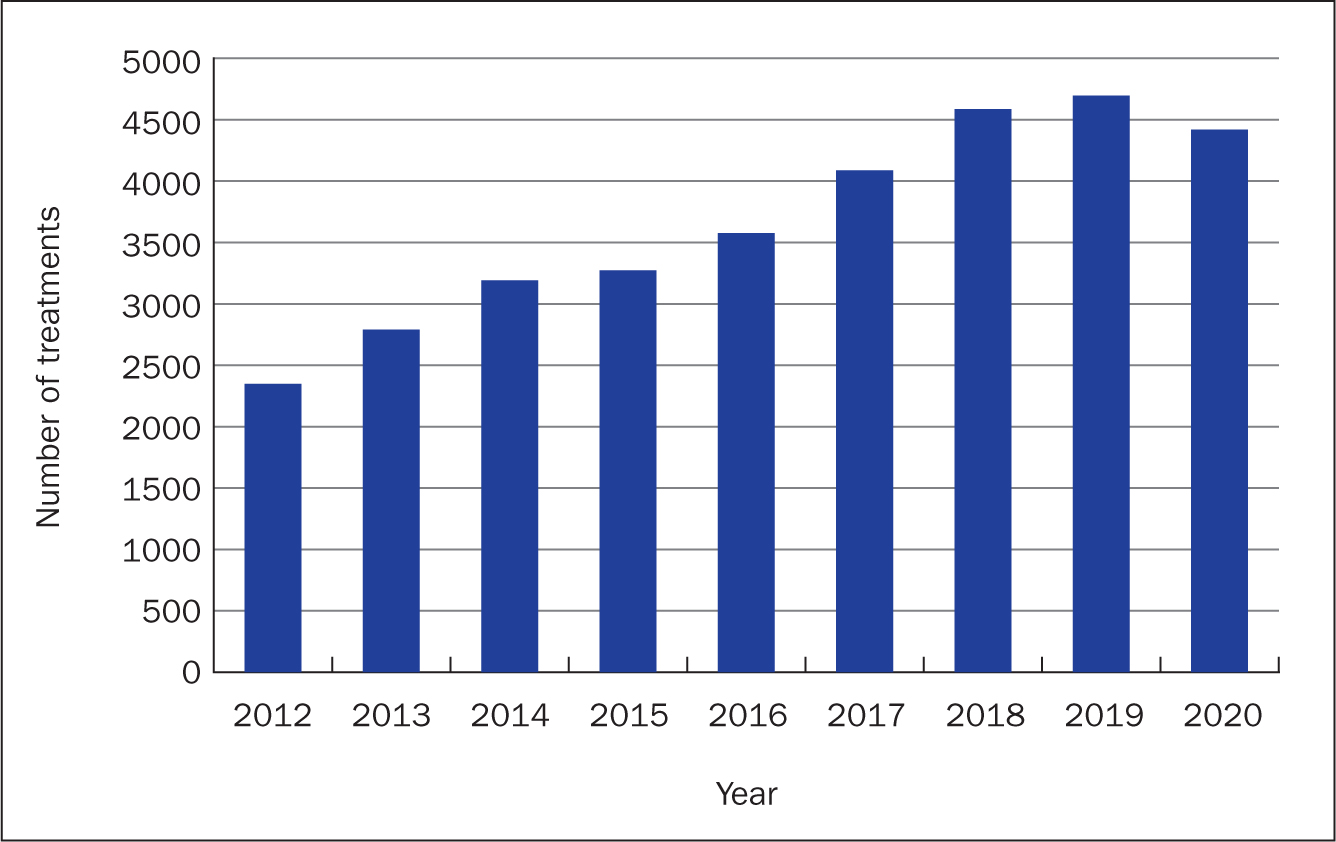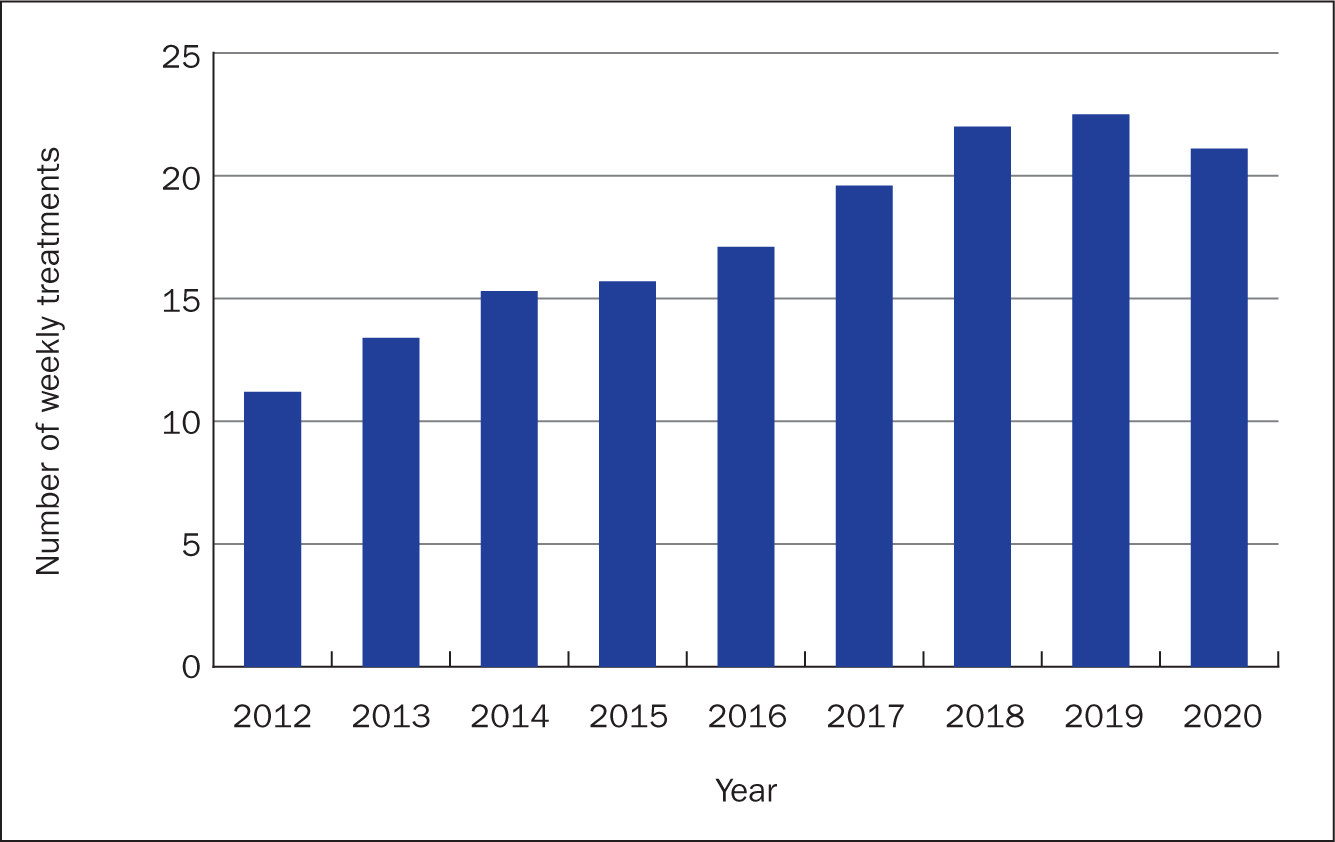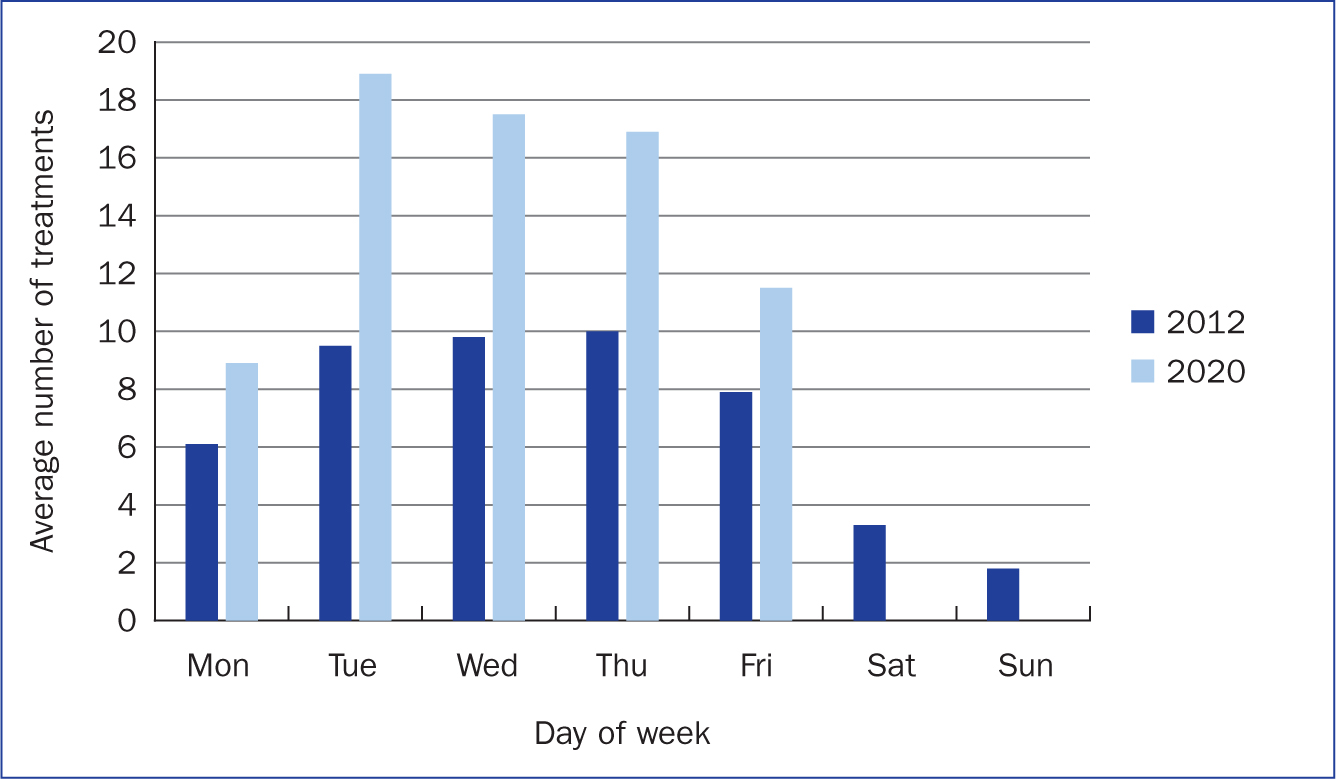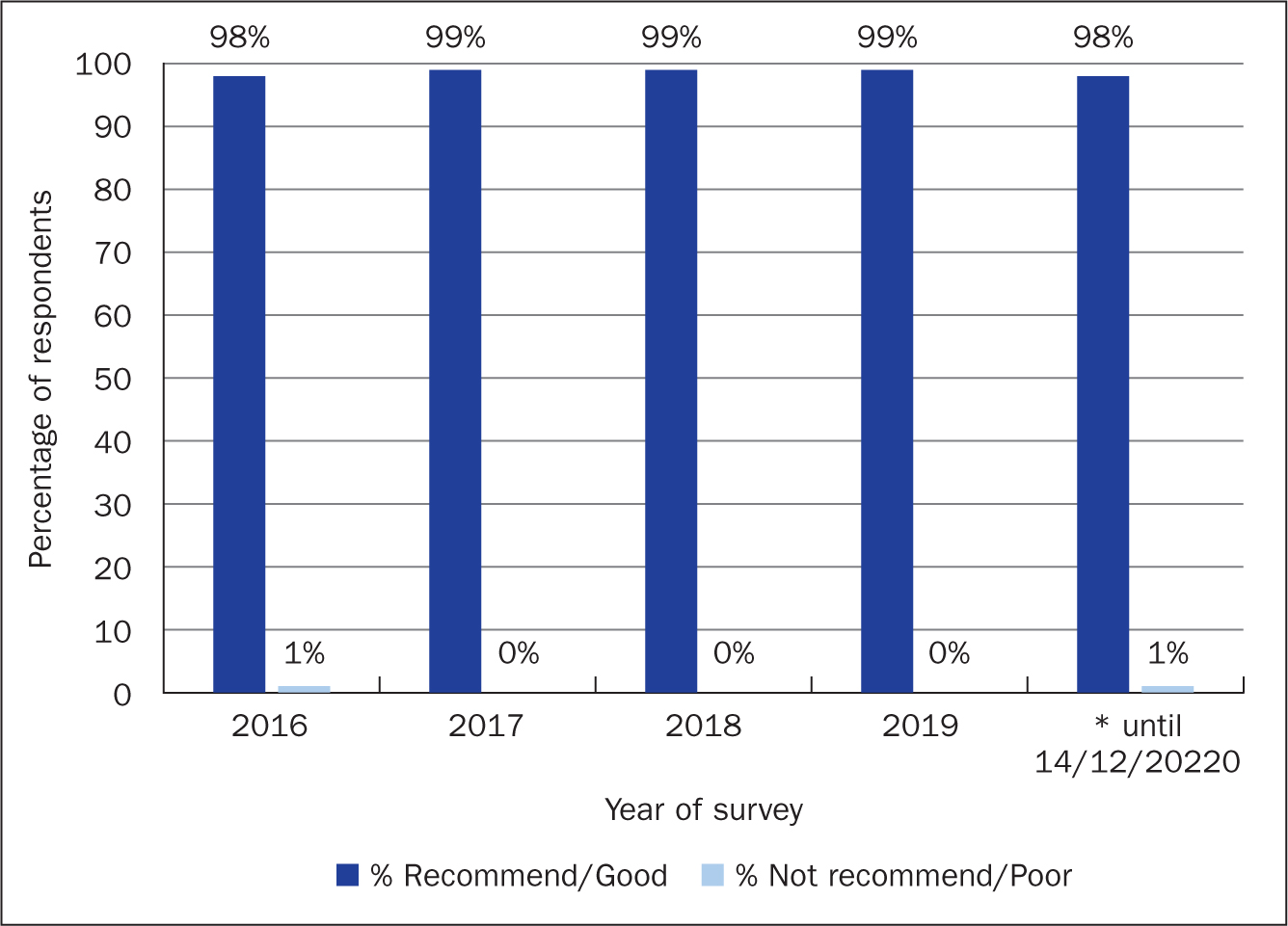Ensuring effective and efficient use of healthcare resources is a system-wide priority. The Guy's and St Thomas' NHS Foundation Trust skin tumour unit, based at Guy's Hospital in London, has been providing extracorporeal photopheresis (ECP) since 2012, using a fully integrated online system. Demand for ECP procedures has continued to increase year on year and the department sought to assess and address the increasing demand for ECP procedures while also maintaining the same number of nurses within the unit. This article summarises the department's 9-year journey of continuous process improvement, which has enabled it to meet the growing demand for ECP treatments for patients with both cutaneous T-cell lymphoma (CTCL) and graft versus host disease (GvHD).
The department formed a partnership with a lean-management company, ProcEx Solutions Ltd, to lead the team through the evaluation of capacity constraints, design layout and patient scheduling using the Kaizen concept (Mazzocato et al, 2016). In 2020 the unit faced challenges as a result of the restrictions imposed due to the COVID-19 pandemic, which would mean that the team would potentially be restricted in the number of patients they would be able to treat. Going without regular ECP treatments could have a devastating effect on patients, and the unit needed to ensure it could continue to provide the service to as many patients as possible but still work within the increased safety restrictions. Using the ProcEx tools, the team were able to minimise the number of reduced treatments, with a reduction of only 6% compared with 2019.
The ECP procedure
ECP is a leukapheresis-based form of cellular immunotherapy that is used to treat a variety of T-cell mediated diseases including cutaneous T-cell lymphoma (CTCL) and both acute and chronic graft-versus-host disease (GvHD). National and international clinical practice guidelines have been published that include ECP as a recommended treatment in CTCL and GvHD (eg from the British Association of Dermatologists and UK Cutaneous Lymphoma Group (Gilson et al, 2019), and the UK Photopheresis Society (Alfred et al, 2017). ECP has also been used as a therapeutic option in solid organ transplant rejection and autoimmune diseases including both scleroderma and Crohn's disease (Scarisbrick et al, 2008; Willemze et al, 2013; Gilson et al, 2019; Knobler et al, 2020; 2021).
The procedure involves the ex-vivo addition of the photosensitising agent, 8-methoxypsoralen (8-MOP), to the mononuclear leukocytes that have been collected from the peripheral blood. During leukapheresis the patient is connected to a cell-separating machine via an intravenous line and approximately 5% of white blood cells are separated from the blood, collected and exposed to 8-MOP. The photosensitised cells are then exposed to ultraviolet–A (UVA) light, resulting in apoptosis (programmed cell death) of the mononuclear cells. The treated cells are then re-infused into the patient (Worel and Leitner, 2012). Although the mechanism of action of ECP is not fully understood, ongoing research continues to provide insight. In addition to apoptosis of the treated mononuclear cells, there is modulation of cytokine production, effects on antigen presenting cells and the generation of regulatory T-cells leading to immune tolerance (Edelson, 2014; Knobler et al, 2020; 2021).
Treatment schedules vary depending on the disease being treated and the observed response (Knobler et al, 2020; 2021). ECP can be performed using an off-line multi-step procedure or an online integrated system. The unit at the Trust uses a fully integrated system, which combines all processes (cell separation, drug photoactivation, and re-infusion) into one procedure where the patient remains connected to the system throughout the treatment. This eliminates the use of multiple separate instruments, which ensures a sterile environment, reduces the risk of improper infusion, and reduces the risk of contamination and infection. The duration of the ECP procedure with fully integrated systems remains shorter than for procedures requiring multiple steps (Bisaccia et al, 2009; Klassen, 2010; Adorno et al, 2013; Pierelli et al, 2013; Knobler et al, 2020; 2021)
Methods
Problem statement and goals
Initially the team devised a problem statement as follows:
‘The ECP unit is experiencing an inability to efficiently increase the number of patients receiving ECP due to design layout, capacity constraints and an ineffective scheduling system resulting in process wastage and increased patient waiting lists.’
They then devised three main goals:
- Increase the number of patients receiving ECP by 25% with no increase in staff, thereby containing current staffing costs
- Identify existing capacity constraints and introduce an efficient capacity demand planning/scheduling system
- Optimise the existing process by efficient utilisation of space, staff, and time.
Data acquisition
The team measured the machine and treatment bed utilisation. They also measured the time intervals for patient activities including pre-observations, cannulation, treatment, and post-observations. These measures would present an understanding of the average times for each activity and the variation therein. With this information the team would then be able to develop a standardised scheduling tool for each patient considering the between-patient variation and equipment utilisation. The authors then measured the total procedures performed by the department over a period of 9 years (2012 to 2020).
Lean scheduling tool (day-by-the-hour)
Using the patient data collected, the team were able to devise a bespoke lean scheduling tool known as ‘day-by-the-hour’. This enabled the department to plan for every patient a day in advance of treatment. On the day of treatment, the progress of each patient against the plan is continually monitored. It also enabled the nurses to schedule break-times methodically. Use of this tool enabled the department to measure bed use daily and enabled filling of vacant appointment slots by calling patients in to occupy any vacant slots that occurred.
Results
Timings for each activity
To generate baseline data, in 2017 the team observed and measured 156 individual patient ECP treatments for a mixture of presenting diseases. Analysis showed that the mean time taken for clinical pre-observations was 4.3 minutes. The mean wait time from patient arrival in the unit to start of cannulation was 11 minutes and the mean time taken for cannulation was 9.1 minutes. This meant that, on average, each patient would wait 24.4 minutes after arrival in the unit to commencement of treatment on the machine. The mean treatment time was 101.8 minutes, and this was measured as the time duration from when the patient was connected to the machine to the time of disconnection. The mean time for post-treatment clinical evaluation was 4.1 minutes. The unit provided 92% of treatments in double-needle mode, this is known to decrease treatment times by 20 minutes on average. The overall average patient duration in the unit was 152 minutes (2 hours, 32 minutes). From this data (Table 1) the team were able to devise a bespoke lean scheduling tool (known as a ‘day-by-the-hour’ board) (Figure 1) and this has enabled the department to treat up to a maximum of 24 patients per 12-hour day.
Table 1. Baseline data measurement of time taken for ECP activity in the unit
| Activity | Mean time (minutes) | SD (minutes) | Number of observations |
|---|---|---|---|
| Pre-observation | 4.3 | 3.8 | 156 |
| Cannulation | 9.1 | 6.1 | 156 |
| Treatment | 101.8 | 23.7 | 156 |
| Post-observation | 4.1 | 3.5 | 156 |
Figure 1. The day-by-the-hour board is the lean scheduling tool devised to help the department make most effective use of treatment stations
Treatment trend by yearly intervals
The total number of ECP treatments was derived from records and divided into yearly intervals covering the period 2012 to 2020 (Figure 2). Over the period between 2012 and 2020, the total number of yearly ECP treatments delivered by the unit increased from 2359 (2012) to 4706 (2019) with a slight decrease (6%) to 4422 in 2020 due to COVID-19 restrictions.
 Figure 2. Number of ECP treatments by year
Figure 2. Number of ECP treatments by year
Nurse productivity
In 2012 the average number of ECP treatments per nurse per week was 11. With the implementation of the new planning tool, and improved working practices, the unit observed year-on-year improvements in nurse efficiency. In 2019 the average number of ECP treatments per nurse per week had more than doubled (in comparison with 2012) to 23 (Figure 3). A slight decrease in 2020 was observed due to COVID-19 restrictions. In 2012 the unit was open 7 days a week, and the team treated an average of 7 patients a day. In 2020 the team treated an average of 15 patients a day. The department was able to eliminate Sunday working in 2014 and eliminated Saturday working from April 2020, reducing the working week to 5 days (Figure 4). The elimination of weekend working has an obvious benefit in terms of staff costs.
 Figure 3. Average number of weekly treatments per nurse
Figure 3. Average number of weekly treatments per nurse  Figure 4. Average treatment numbers by day of week
Figure 4. Average treatment numbers by day of week
Increased revenue
As a result of the process improvement project, the unit has been able to meet the demand for treating patients with ECP since 2012 without increasing the number of nurses. The total income generated by the additional number of patients gave rise to an increase in revenue from £3.8 million (2012) to £7.5 million (2019) (Table 2). A slight decrease was observed in 2020 due to COVID-19 restrictions.
Table 2. Treatments carried out and revenue for the unit
| Yesr | Number of ECP treatments | Unit revenue per treatment | Annual reimbursement | Number of nurses |
|---|---|---|---|---|
| 2012 | 2359 | £1585 | £3 739 015 | 4 |
| 2013 | 2804 | £1585 | £4 444 340 | 4 |
| 2014 | 3194 | £1585 | £5 062 490 | 4 |
| 2015 | 3282 | £1585 | £5 201 970 | 4 |
| 2016 | 3584 | £1585 | £5 680 640 | 4 |
| 2017 | 4095 | £1585 | £6 490 575 | 4 |
| 2018 | 4596 | £1585 | £7 284 660 | 4 |
| 2019 | 4706 | £1585 | £7 459 010 | 4 |
| 2020 | 4422 | £1585 | £7 008 870 | 4 |
Friends and family satisfaction survey
In 2016 the department introduced a survey to monitor patient satisfaction levels with the service, using the standard NHS Friends and Family Test survey. In the period 1/1/16 to 31/12/20 a total of 1206 surveys were completed. Overall, the team are satisfied with the results, but continue to monitor this very important aspect of the service (Figure 5).
 Figure 5. Annual NHS Friends and Family survey results for the ECP service
Figure 5. Annual NHS Friends and Family survey results for the ECP service
Discussion
‘Lean’ is a methodology that is currently employed by many businesses, government agencies and healthcare providers and aims to optimise working processes and eliminate waste. The fundamental lean principle proposes that the expenditure of resources for any goal other than the creation of value—defined in this context as an attribute that adds benefit for the patient—is wasteful. In the clinical setting, process improvement strategies based on lean solutions can reduce costs, dramatically improve processing times, and free up valuable staff to undertake more productive work. Such gains can be directly translated into availability of extra capacity and improved patient care (Burgess, 2011; Rushton et al, 2016; Lean Enterprise Institute, 2021)
Implementation of quality improvement tools and incorporating lean methodology in this ECP unit has enabled standardisation of practices, improved clinic efficiency and has resulted in the service being more cost effective. This has resulted in improved patient access due to the less complex support structure. The team were able to standardise the patient pathway with fixed appointment times using a lean scheduling tool termed day-by-the-hour. They conclude that because of the success of the programme, more patients with presenting disease states have benefited from accessing ECP treatment.
The ongoing success of the unit's ability to increase capacity enabled the team to introduce an outreach service in 2018. They have continued to support two external hospitals within the London area and are able to treat vulnerable patients who were unable to travel to the Guy's Hospital unit for ECP. More recently the team have been challenged by the restrictions both in-house and to the outreach service due to the COVID-19 pandemic. By using the ProcEx tools the team were able to follow a systematic approach enabling the outreach clinical nurse specialist to continue to treat patients in a timely manner with the continued high level of care. The tool also enabled effective communication between the in-house and the outreach services. The overall reduction in 2020 was only 6% fewer treatments compared with the previous year (2019: 4706 treatments, 2020: 4422 treatments), which is commendable.
Conclusion
One of the biggest drivers of success behind this project has been leadership and continuous monitoring of performance. Also, engagement from staff at all levels has been paramount in the continued success. Without these two aspects the gains will not be sustained. The team accept that efficiency improvements will also be observed as staff become more experienced but, because of the systematic process the unit has developed, it appears to be the case that new staff adapt rapidly to the standardised process so that efficiency levels are maintained. The service continues in its mission to grow and provide a superior patient experience. An ongoing monthly data analysis has been put in place whereby the team monitor progress against targets. If they observe a decline in performance such as fewer patients being treated, or the build-up of a waiting list, immediate and appropriate action is taken to rectify the issues. There is also a quarterly on-site audit process carried out by ProcEx Solutions Ltd (2021).
KEY POINTS
- Without ongoing and meaningful data measurement it is impossible to improve services
- The team examined the processes and time spent on extraocoporeal photopheresis treatment in order to make the most effective use of the resources available
- Following the introduction of the systematic process and standardised patient pathway, the number of treatments doubled, with the same number of nurses, eliminating the need for weekend working
- Patients are treated on time every time, with very high patient satisfaction scores
CPD reflective questions
- Think about the main areas within your processes that would benefit from process improvement
- Do you have appropriate metrics measures in place to continually monitor performance and drive improvement?
- What are the barriers in your workplace that are preventing you from implementing process improvement strategies?
- How could you utilise lean tools such as the ‘day-by-the-hour scheduling tool’ to help improve efficiencies in your unit?


